Audrey and I have a stable of 16 small boats, and we often need to move them off and on trailers for maintenance and repairs. Audrey has a background in theater-set construction where the crews avoided lifting anything when a lever, dolly, line, or block-and-tackle would do, and after watching me struggle while moving boats, she designed a simple sling lift to reduce wear on me as well as the boats.
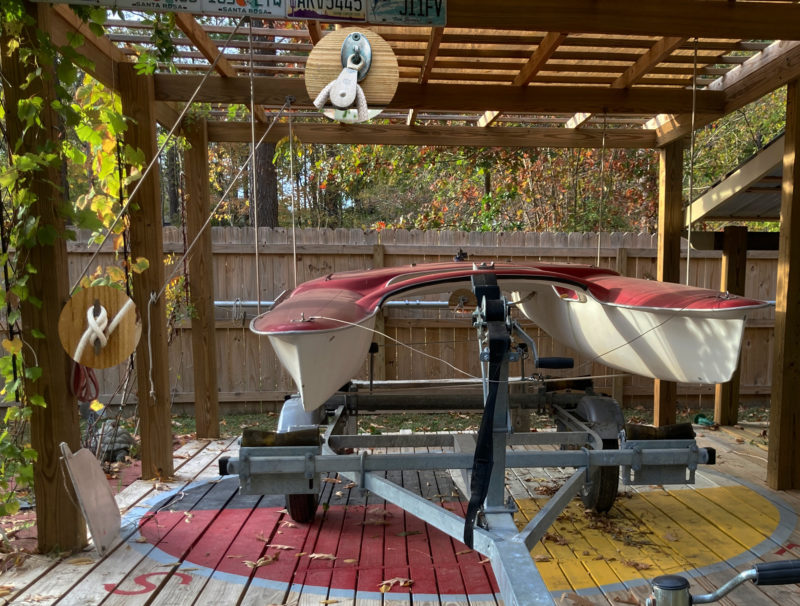 Photographs by the authors
Photographs by the authorsEach sling in the authors’ pergola has a cleat (left) to secure the working end and a single block (top) secured to an overhead beam with a pad eye. The stationary end of the line is secured to another pad eye. Here the author’s 1965 Alcort Catfish is being lifted from its trailer for some hull repairs.
The lift’s two slings are made up of items from our hardware and rigging boxes: two retired 25′, 5⁄16″ mainsheets; an eye-strap for the end of each line; two blocks; and two cleats. We have a pergola that provides a suitable structure for the lift, but slings can also be easily installed on shed rafters, garage joists, or a free-standing, purpose-built frame. Our pergola’s 2×6 beams easily bear the weight of our boats; our previous sling lift was hung from 2×4s and they, too, were strong enough.
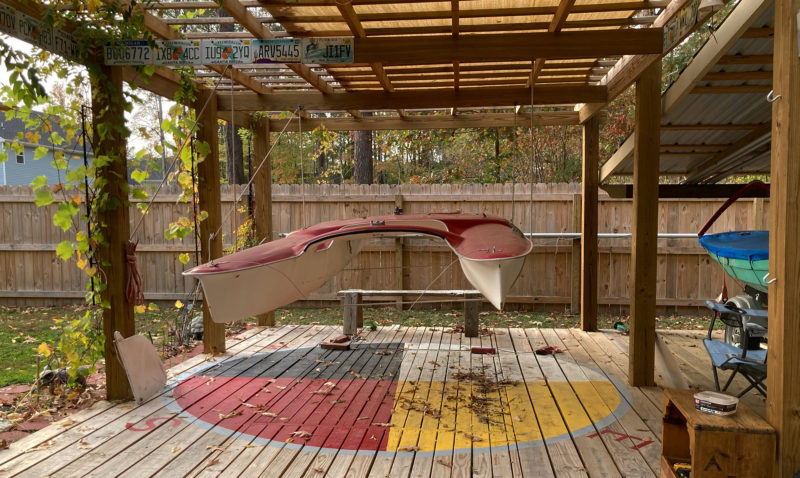
With the trailer pulled out from under the boat, there is easy access for any work that needs to be done. With fully exposed support beams like those in the pergola, the ends of the slings and the pulleys could be tied in place without the need for pad eyes.
The slings provide a bit of mechanical advantage—the boat itself is the moving block of a gun tackle system—and to date we’ve used the lift to hoist boats up to 200 lbs, but it could lift heavier boats. We attached the hardware with marine-grade screws or bolts, because our lift is exposed to the weather, and spaced the two slings about 8′ apart. This setup works for all of our boats, which range in length from 12′ to 14′.
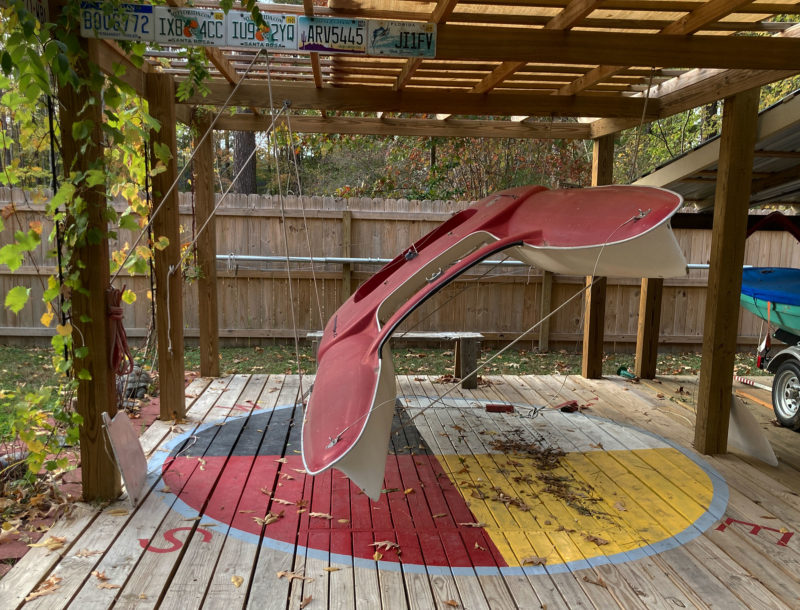
Supported by the two slings, the boat can be set at an angle to make it easier to work on.
To lift a boat, we slip a sling under each end. The well-worn mainsheets’ soft braided covers were easy on the hands when they were used for sailing and are just as gentle on varnished or painted wood. We avoided using hard braided line or coarse twisted line, which could leave scars. We’ll use padding if we think even our soft mainsheets might mar a fine finish or paint that is not fully cured. We use old bath towels and pool noodles for padding; pipe insulation would work, too.
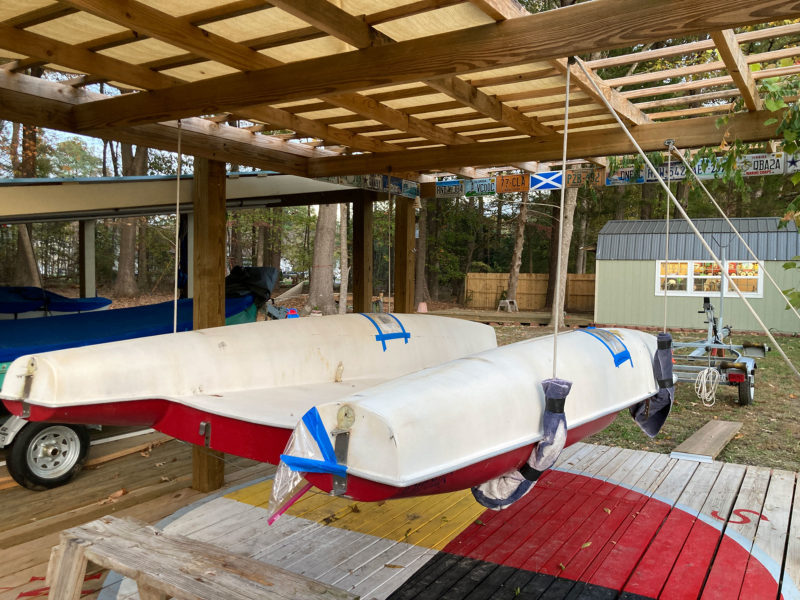
For work on the bottom of the catamaran, it has been rotated 180 degrees. Towels rolled and taped around the slings are one means of protecting finishes that might be marred by direct contact with the sling.
I can use one sling at a time to move boats up and down by myself, but when Audrey and I team up, we still lift a boat off its trailer one end at a time, because it reduces the effort required. After lifting an end, one of us cleats off the line and then we do the lift with the other sling on the other end. The boat will roll as the sling raises it, which is useful if there’s work to be done on the bottom and we intend to flip the boat over. If the boat is to remain upright, we cleat both slings and lift the low gunwale to bring the boat back to level or tipped beyond level in anticipation of another lift. Once a boat is hoisted, it is a simple matter to gently roll it in the sling to work on the bottom.
With our 16 boats, six trailers, and six dollies, we use our sling lift whether getting a boat off its trailer to gain easier access to it while working on the bottom, or shifting boats between trailers.![]()
Audrey (aka Skipper) and (aka Clark) Kent Lewis blog about their boat shuffling at Small Boat Restoration.
You can share your tips and tricks of the trade with other Small Boats Magazine readers by sending us an email.




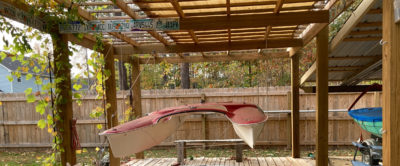
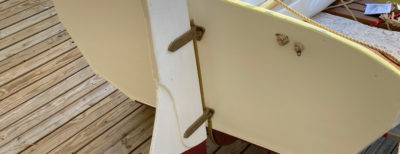
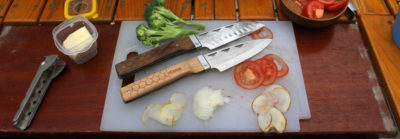

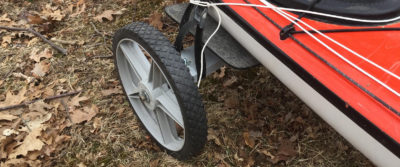

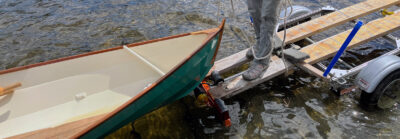
Does anyone have plans for a purpose-built frame that could be built to support the cleats, pulleys, and boat? I have a 125-140# monohull to flip. Please reply to [email protected].
Thank you.
Nice article, what many would consider a difficult task, made easy and well explained.
I’ve done a version of this which also acts as part of a small-boat storage system. A webbing sling goes under the hull from spreaders to which the hoisting line is attached. In the loft of the garage there are a bunch of blocks as the fore and and aft slings are married to a line that goes to the critical component of my system, a trailer winch mounted to one of the studs on the garage wall. I set up the webbing slings around the boat on a trailer, then start cranking on the winch and the boat goes up. I’ve also used the system to hoist a skiff for easy bottom painting.
Here’s a photo
I too work in theatre, I have been considering a pair of 1/4-ton chain hoists for this same purpose. As they run on 120v unlike their bigger 1/2- and 1-ton cohorts, I could easily run them in my garage. This system they came up with has the advantages of being much cheaper and a lot more simple to implement.
I like that spreader idea. It is important to set our attachment points wide enough to not pull a hull inward, better to be too wide than not wide enough. Your spreaders take care of that.
One of the things not obvious in the pic of my ducker is that I have a block on each spreader so that gives me a 2×1 purchase before it gets to the winch.
As a one man band building a 4-meter dinghy, I have been looking for a method to turn the boat over safely and this system could be just the ticket
What a useful solution and discussion that elaborates on it.